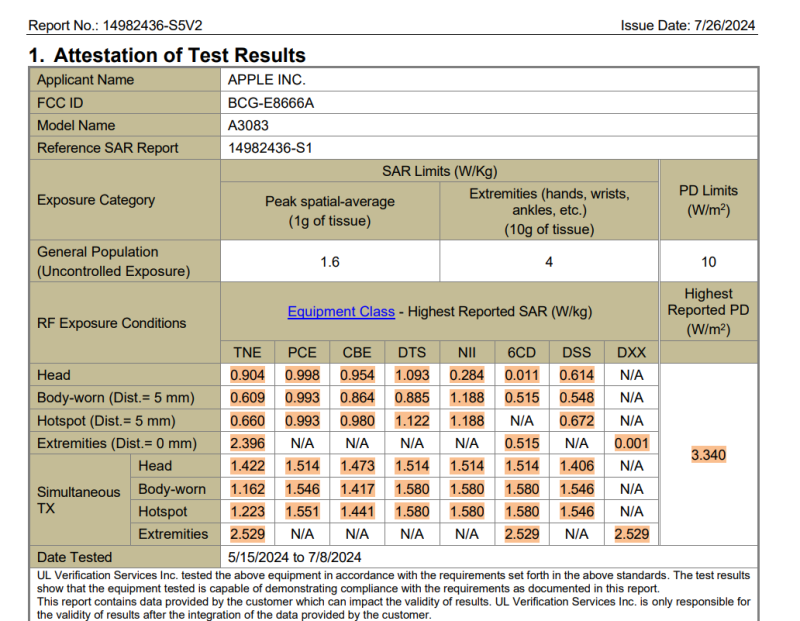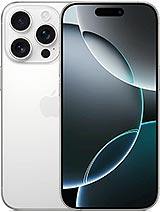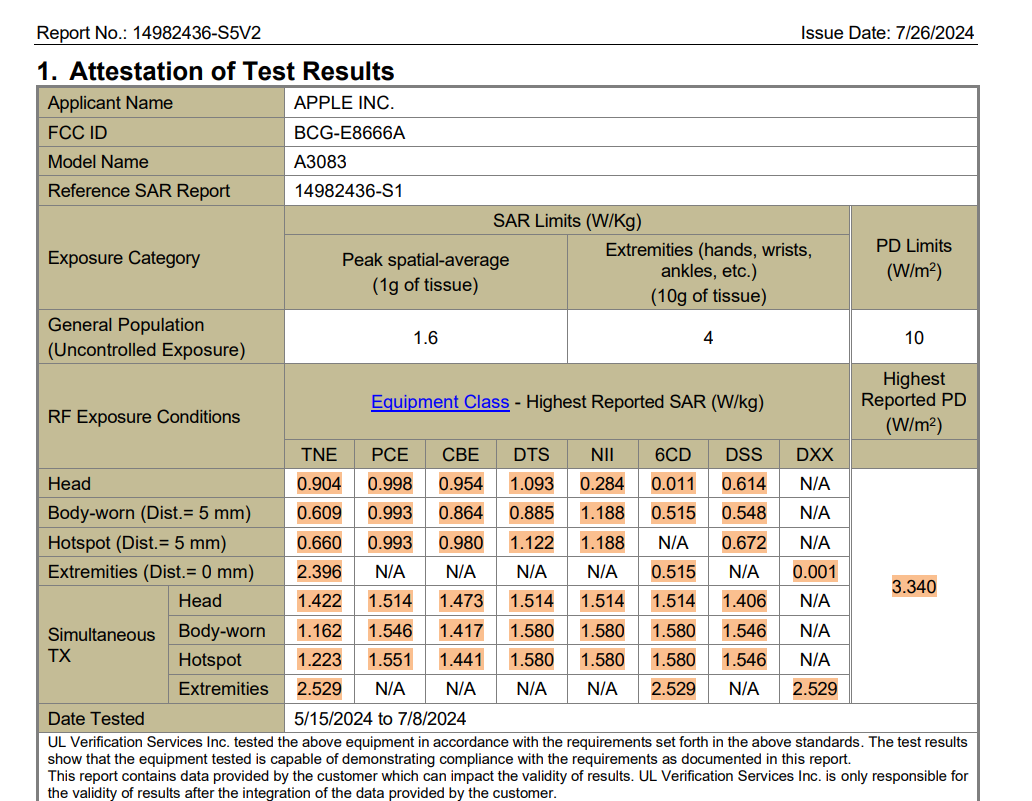Apple iPhone 16 Pro SAR Level Summary:
The cellular transmission SAR values for the Apple iPhone 16 Pro (FCC ID BCG-E8666A) are 1.09 W/kg (watts per kilogram) at the head and 1.19 W/kg when worn on the body. The hotspot/Airplay SAR level is 1.58 W/kg. The simultaneous transmission SAR values for iPhone 16 Pro (cellular plus Wi-Fi) is 1.51 W/kg at the head, 1.58 W/kg when worn on the body, and 1.58 W/kg when used as a hotspot simultaneously with other transmitters active.
Which iPhone 16 Model Has the Lowest Radiation?
iPhone 16 Pro
| Radiation Levels | Head | Body | Hot Spot |
|---|---|---|---|
| Cellular Only | 1.09 W/kg | 1.19 W/kg | 1.58 W/kg |
| Wi-Fi + Cellular | 1.51 W/kg | 1.58 W/kg | 1.58 W/kg |

Apple iPhone 16 Pro SAR Level Analysis and RF Radiation Risks
Introduction
As new models of smartphones hit the market, many consumers remain unaware of the underlying risks associated with radiofrequency (RF) radiation. The Apple iPhone 16 Pro (FCC ID: BCG-E8666A) represents the latest in technological advancements, but it also exposes users to radiation levels that fall within FCC guidelines—which have not been updated in over 25 years. These standards were established long before the proliferation of smartphones, Wi-Fi, and 5G technology.
In this article, we’ll break down the Specific Absorption Rate (SAR) levels for the Apple iPhone 16 Pro, and delve into why it’s crucial to reassess the potential health risks associated with RF radiation, especially in light of growing scientific evidence that questions the adequacy of current regulations.
SAR Level Breakdown for iPhone 16 Pro
iPhone 16 Pro
Apple iPhone 16 Pro
Apple iPhone 16 Pro

$69.99 Original price was: $69.99.$45.47Current price is: $45.47.
| Apple iPhone 16 Pro |
|---|
| Head SAR (Cellular Only) |
| 1.09 W/kg |
| Body SAR (Cellular Only) |
| 1.19 W/kg |
| Hot Spot SAR (Cellular Only) |
| 1.58 W/kg |
| Head SAR (Wi-Fi + Cellular) |
| 1.51 W/kg |
| Body SAR (Wi-Fi + Cellular) |
| 1.58 W/kg |
| Hot Spot SAR (Wi-Fi + Cellular) |
| 1.58 W/kg |
Here’s a detailed table showcasing the SAR values of the iPhone 16 Pro, which are within the FCC’s limits but may not necessarily reflect the true safety of prolonged exposure.
| Parameter | Value |
|---|---|
| FCC ID | BCG-E8666A |
| Model Name | A3083 (iPhone 16 Pro) |
| Head SAR | 1.09 W/kg (DTS Condition) |
| Body-worn SAR | 1.19 W/kg (DTS Condition) |
| Hotspot SAR | 1.19 W/kg (DTS Condition) |
| Extremities SAR | 2.39 W/kg (TNE Condition) |
| Simultaneous Transmission SAR | |
| – Head | 1.51 W/kg (PCE, DTS, NII Conditions) |
| – Body-worn | 1.58 W/kg (NII, DSS Conditions) |
| – Hotspot | 1.58 W/kg (NII, DSS Conditions) |
| – Extremities | 2.53 W/kg (TNE, DXX Conditions) |
What is SAR?
SAR, or Specific Absorption Rate, measures how much RF energy is absorbed by the human body when using a device like a smartphone. The FCC’s SAR limit for public exposure is set at 1.6 W/kg for the general population, meaning devices must not exceed this value for safe usage.
Simultaneous Transmission Risks
While SAR values for individual transmissions (like when the phone is in a single-use state) fall below the limits, simultaneous transmissions—when your phone is using both Wi-Fi and cellular data—often push these values close to the maximum allowable limits. In the case of the iPhone 16 Pro, simultaneous transmission values reach 1.51 W/kg for the head and 1.58 W/kg for body-worn use, raising concerns about the cumulative exposure people face as they use these devices throughout the day.
Regulatory Gaps and Outdated Standards
The FCC’s SAR guidelines, which were last updated over 25 years ago, are based primarily on thermal effects—the idea that RF radiation is only harmful when it causes measurable heating of body tissues. However, a growing body of scientific research suggests that RF radiation can have non-thermal biological effects as well. These effects can occur at radiation levels below the current SAR limits and may include:
- DNA Damage
- Increased Cancer Risk
- Oxidative Stress
- Neurological Disorders
- Reproductive Harm
The Legal Battle: RFK Jr. vs. FCC
In a landmark case brought by RFK Jr. and the Environmental Health Trust, the FCC was sued for failing to update its guidelines in light of modern research. The court ruled that the FCC had ignored significant scientific evidence on the potential health risks of RF radiation, particularly for children, and had not properly reviewed the guidelines since 1996.
This lawsuit was a major step toward holding regulatory bodies accountable for failing to protect public health in the face of mounting evidence. Yet, despite the court’s decision, FCC standards remain unchanged, leaving the public vulnerable to the potential hazards of daily, prolonged exposure to RF radiation.
Scientific Studies Confirming the Risks of RF Radiation
Several studies have demonstrated that RF radiation can cause biological harm, challenging the belief that current SAR limits provide adequate protection.
1. The National Toxicology Program (NTP) Study
The NTP study remains one of the largest and most comprehensive investigations into the long-term effects of RF radiation. The study exposed rats and mice to RF levels similar to those emitted by cell phones. The findings were clear:
- Glioblastomas (brain cancer) were observed in male rats.
- Schwannomas (heart tumors) were found in exposed animals.
- The study provided clear evidence of carcinogenic activity, challenging the notion that current SAR guidelines are protective enough.
| NTP Study Findings | Significance |
|---|---|
| Glioblastomas | Brain cancer in rats exposed to RF radiation |
| Schwannomas | Heart tumors linked to RF exposure |
| Clear carcinogenic activity | Calls for immediate revision of SAR guidelines |
Despite these findings, the Biden-Harris administration halted additional research into the effects of RF radiation, depriving the public of critical updates to safety standards.
2. The Ramazzini Institute (RI) Study
The Ramazzini Institute conducted a similar study in Italy, exposing rats to lower levels of RF radiation, comparable to what people experience near cell towers. The results mirrored the NTP study:
- Schwannomas were found in male rats, reinforcing the evidence that even low-level, non-thermal exposure can cause cancer.
- An increase in malignant tumors was observed in the exposed animals, further demonstrating the cancer risks associated with RF exposure.
Why Current FCC Guidelines are Inadequate
The FCC’s guidelines, which focus solely on thermal effects, fail to consider the growing body of evidence that points to non-thermal biological damage caused by RF radiation. Some of the potential risks include:
1. DNA Damage
Studies have shown that RF radiation can cause genetic mutations and DNA strand breaks, which can lead to cancer. These changes occur without the tissue heating that the FCC guidelines are designed to prevent.
2. Oxidative Stress
Oxidative stress, a state where free radicals overwhelm the body’s natural defenses, is a known contributor to many diseases, including cancer and neurological disorders. Research shows that RF radiation can increase oxidative stress, leading to long-term health problems.
3. Impact on Children
Children are more vulnerable to RF radiation because their bodies are still developing. The Environmental Health Trust has repeatedly highlighted that current SAR limits do not adequately protect children, whose smaller heads and thinner skulls allow for deeper penetration of RF energy.
| Non-Thermal Effect | Health Impact |
|---|---|
| DNA Damage | Cancer and genetic mutations |
| Oxidative Stress | Accelerated aging, chronic diseases |
| Neurological Effects | Cognitive impairment, behavioral issues |
| Reproductive Harm | Reduced fertility, birth defects |
Mitigating the Risk: Steps You Can Take
Although regulatory agencies have failed to take action, there are steps that consumers can take to reduce their exposure to RF radiation. Here’s how you can protect yourself and your family:
1. Limit Exposure
Use speakerphone or wired headphones instead of holding the phone directly against your head. Limit your screen time, particularly for children.
2. Invest in RF-Safe Products
Consider using products that reduce radiation exposure, such as RF-safe phone cases, air-tube headsets, or shields designed to deflect radiation away from the body.
3. Turn Off Wireless Functions
When not in use, disable Wi-Fi and Bluetooth to reduce your cumulative exposure to RF radiation.
4. Distance Matters
Keep your phone at least 5mm away from your body, and avoid storing it in your pocket or bra. The SAR values for body-worn devices increase the closer they are to the skin.
A Call to Action
The SAR values for the iPhone 16 Pro may fall within the FCC’s outdated guidelines, but the growing body of scientific evidence suggests that these limits are no longer sufficient to protect public health, especially from non-thermal effects of RF radiation.
The landmark case led by RFK Jr. and the Environmental Health Trust highlighted the regulatory failures of the FCC, yet no action has been taken to update these guidelines. It’s up to the public to demand change and to take proactive measures to reduce exposure.
The health of future generations depends on recognizing the risks of RF radiation today. By staying informed and advocating for updated regulations, we can ensure that wireless technology becomes safer for everyone.
Take Action:
- Educate yourself and others on the risks of RF radiation.
- Demand updated safety standards from regulatory bodies like the FCC.
- Invest in protective products that help reduce your exposure to RF radiation.
Your health—and the health of your children—depends on staying informed and taking steps to mitigate the risks associated with wireless technology.
Apple iPhone 16 Pro RF Safe FAQs
What is the SAR value for the Apple iPhone 16 Pro?
The SAR (Specific Absorption Rate) value for the Apple iPhone 16 Pro (FCC ID: BCG-E8666A) is 1.09 W/kg at the head and 1.19 W/kg when worn on the body. These values measure the amount of radiofrequency (RF) energy absorbed by the body when using the phone.
Is the SAR level of the iPhone 16 Pro within safe limits?
Yes, the iPhone 16 Pro’s SAR levels fall within the FCC’s limit of 1.6 W/kg for the general population. However, it’s important to note that these guidelines are over 25 years old and may not account for modern wireless technology’s potential non-thermal health risks.
How does the iPhone 16 Pro’s SAR compare to other smartphones?
The SAR levels of the iPhone 16 Pro are comparable to other high-end smartphones. Its 1.09 W/kg for head and 1.19 W/kg for body values are similar to competing models, but users should still be mindful of RF exposure over long periods.
What is the simultaneous transmission SAR value for the iPhone 16 Pro?
For simultaneous transmission, where multiple wireless systems (like Wi-Fi and cellular) are active, the SAR value for the head is 1.51 W/kg and for the body is 1.58 W/kg. This means more RF energy is absorbed during multi-connection use, such as streaming or hotspotting.
How can I reduce RF exposure from my iPhone 16 Pro?
To reduce RF exposure from your iPhone 16 Pro, consider using speakerphone, wired headphones, and limiting direct contact with your body. Keeping your phone 5mm away from your skin and disabling wireless features like Wi-Fi or Bluetooth when not in use also helps lower exposure.
Does the iPhone 16 Pro pose a health risk due to RF radiation?
While the iPhone 16 Pro meets FCC standards, studies suggest that non-thermal effects of RF radiation, such as DNA damage and oxidative stress, could pose health risks over time, especially with prolonged exposure. It’s important to minimize unnecessary exposure.
Are SAR values the only measure of safety for smartphones?
No, SAR values are just one measure of safety. They only account for the thermal effects of RF radiation, but growing evidence suggests that non-thermal effects—like oxidative stress and neurological impacts—should also be considered when assessing smartphone safety.
Can children use the iPhone 16 Pro safely?
Children are more vulnerable to RF radiation because their smaller heads and thinner skulls allow for deeper penetration of RF energy. While the iPhone 16 Pro meets current SAR guidelines, parents may want to limit their children’s exposure to reduce potential health risks.
What are the extremity SAR values for the iPhone 16 Pro?
The SAR value for the extremities (e.g., hands or wrists) when holding the iPhone 16 Pro is 2.39 W/kg for single transmissions and up to 2.53 W/kg for simultaneous transmissions. These values are under the 4 W/kg limit set for extremities but represent higher localized RF exposure.
Should I be concerned about RF radiation from the iPhone 16 Pro?
Though the iPhone 16 Pro complies with FCC SAR limits, growing scientific research suggests that long-term exposure to RF radiation—especially from simultaneous wireless connections—could pose health risks, including cancer and neurological disorders. Reducing direct exposure and staying informed about updated safety standards is recommended.
Here’s the breakdown of the Apple iPhone 16 Pro (Model A3083) SAR report (FCC ID: BCG-E8666A), including the highest reported SAR values, as well as an explanation for each section.
Breakdown of SAR Table:
Applicant Name & FCC ID:
- Applicant Name: Apple Inc., the entity applying for FCC certification.
- FCC ID: BCG-E8666A, the unique identifier for the Apple iPhone 16 Pro (Model A3083).
Reference SAR Report:
- Reference SAR Report: Report 14982436-S1, which relates to a previous SAR testing session for the device.
SAR Limits (W/kg):
- Peak Spatial-Average (1g of tissue): The SAR limit for general population/uncontrolled exposure is 1.6 W/kg for 1g of tissue.
- Extremities (10g of tissue): The SAR limit for extremities (e.g., hands, wrists, ankles) is 4 W/kg.
Exposure Categories:
- General Population / Uncontrolled Exposure: These limits are applied to the public without special controls, ensuring devices remain below these thresholds.
RF Exposure Conditions:
These describe the various situations the phone is tested in to simulate real-world usage:
- TNE: Test Network Environment.
- PCE: Peak Controlled Exposure.
- CBE: Controlled Body Exposure.
- DTS: Device Test Scenario.
- NII: Non-Intentional Interference.
- 6CD: Six-Class Domain.
- DSS: Dynamic Spectrum Sharing.
- DXX: Dynamic Excess Exposure.
SAR Values (W/kg):
- Head: SAR when the phone is held against the head.
- Body-worn (Dist. = 5 mm): SAR when the phone is carried close to the body (e.g., in a pocket).
- Hotspot (Dist. = 5 mm): SAR when the device is used as a hotspot.
- Extremities (Dist. = 0 mm): SAR when the phone is held directly against the hands, wrists, etc.
Simultaneous Transmission (TX):
These values indicate SAR when multiple wireless systems (e.g., cellular and Wi-Fi) are transmitting at the same time:
- Head (Simultaneous TX): SAR measured when the device is near the head during simultaneous transmission.
- Body-worn (Simultaneous TX): SAR when the device is close to the body during simultaneous transmission.
- Hotspot (Simultaneous TX): SAR during simultaneous transmission while using the device as a hotspot.
- Extremities (Simultaneous TX): SAR when held against extremities during simultaneous transmission.
Power Density (PD) Results:
- PD Limit (W/m²): General public safety limit for exposure at frequencies above 6 GHz is 10 W/m².
- Highest Reported PD (W/m²): The highest power density reported here is 3.340 W/m², well below the limit.
Date Tested & Test Results:
- Date Tested: Testing was conducted between 5/15/2024 and 7/8/2024.
- Test Results: The device passed the test, indicating it complies with the FCC’s safety guidelines.
Highest Reported SAR (W/kg) for Apple iPhone 16 Pro (A3083):
- Head (single TX):
- 1.093 W/kg under the DTS condition.
- Body-worn (Dist. = 5 mm):
- 1.188 W/kg under the DTS condition.
- Hotspot (Dist. = 5 mm):
- 1.188 W/kg under the DTS condition.
- Extremities (Dist. = 0 mm):
- 2.396 W/kg under the TNE condition.
Simultaneous Transmission (TX) SAR Values:
- Head (Simultaneous TX):
- 1.514 W/kg under multiple conditions (PCE, DTS, NII).
- Body-worn (Simultaneous TX):
- 1.580 W/kg under multiple conditions (NII, DTS, DSS).
- Hotspot (Simultaneous TX):
- 1.580 W/kg under multiple conditions (NII, DTS, DSS).
- Extremities (Simultaneous TX):
- 2.529 W/kg under the TNE and DXX conditions.
The Apple iPhone 16 Pro (Model A3083) falls well within the FCC’s guidelines for RF exposure, with SAR values peaking at 1.188 W/kg for body-worn and hotspot usage, and 2.396 W/kg for extremities in single transmission conditions.
It is worth emphasizing that the FCC’s SAR guidelines, last updated over 25 years ago, are based on thermal effects and may not adequately protect users from the non-thermal effects of RF exposure, especially children. In a landmark case, RFK Jr. and the Environmental Health Trust challenged the FCC, arguing that the current guidelines fail to consider the latest scientific evidence on the biological impacts of RF radiation. The court ruled that the FCC had neglected to review relevant research, highlighting the urgent need for updated safety regulations that reflect modern technology usage.
Readers are encouraged to reduce RF exposure by utilizing RF Safe products or other protective measures to mitigate potential health risks, especially as wireless devices become more pervasive in daily life.








